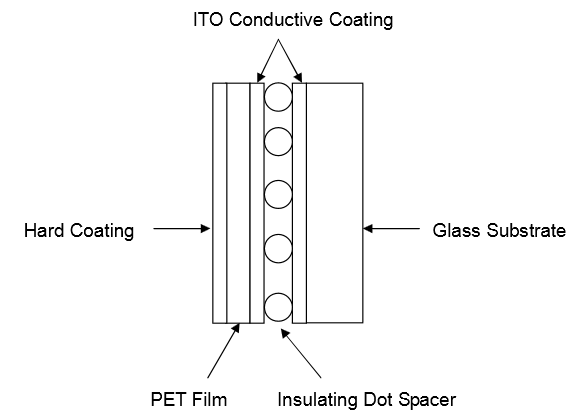Imagine your life without cell phone...
What a nightmare!
Don't worry no one is taking the vital thing from you...
Every wondered
There are different technologies for making the touch screen work
The one i ll discuss in this post ll be RESISTIVE TOUCH SCREEN... Well if u ask me why this first then its because it is least expensive so when i post the next one feel RICHER $$$
RESISTIVE TOUCHSCREEN
is composed of glass panel and PET(Polyethylene terephthalate) film screen each coated with uniform conductive ITO(Indium Tin Oxide) on one side which is facing each other and having insulating Dot spacers in between.

Working
When screen is touched the pressure causes the ITO coating on PET film to be pushed and touches the ITO coating on glass substrate resulting in electrical contact producing voltage which depicts the position touched.
Co-ordinate finding
The pins X(left) and X(right) are on glass substrate and Y(left) and Y(right) are on PET film.
For measuring the X coordinate the microprocessor applies +5V to pin X(left) and the voltage uniformly decreases to 0V at X(right) due to resistive ITO layer and during this the PET film is grounded. The reading on PET film depicts the X coordinate. If the microprocessor detects no voltage it means the screen is not touched however if it is touched, a VOLTAGE on the glass substrate proportional to X coordinate of the touch appears on the PET film.This analog voltage is digitized by A/D converter and stored to transfer to the host, giving X coordinated.
In the next electrical cycle, the Y coordinate is measured in the same way as depicted above only now the +5V is applied to the PET film and reading is obtained from the glass film.
Advantages
Keep following my blog so that u don't miss any of the Hi Tech talks!!!
What a nightmare!
Don't worry no one is taking the vital thing from you...
Every wondered
HOW THE TOUCH SCREEN WORKS!
Well lets ponder upon...There are different technologies for making the touch screen work
The one i ll discuss in this post ll be RESISTIVE TOUCH SCREEN... Well if u ask me why this first then its because it is least expensive so when i post the next one feel RICHER $$$
RESISTIVE TOUCHSCREEN
is composed of glass panel and PET(Polyethylene terephthalate) film screen each coated with uniform conductive ITO(Indium Tin Oxide) on one side which is facing each other and having insulating Dot spacers in between.
Working
When screen is touched the pressure causes the ITO coating on PET film to be pushed and touches the ITO coating on glass substrate resulting in electrical contact producing voltage which depicts the position touched.
Co-ordinate finding
The pins X(left) and X(right) are on glass substrate and Y(left) and Y(right) are on PET film.
For measuring the X coordinate the microprocessor applies +5V to pin X(left) and the voltage uniformly decreases to 0V at X(right) due to resistive ITO layer and during this the PET film is grounded. The reading on PET film depicts the X coordinate. If the microprocessor detects no voltage it means the screen is not touched however if it is touched, a VOLTAGE on the glass substrate proportional to X coordinate of the touch appears on the PET film.This analog voltage is digitized by A/D converter and stored to transfer to the host, giving X coordinated.
In the next electrical cycle, the Y coordinate is measured in the same way as depicted above only now the +5V is applied to the PET film and reading is obtained from the glass film.
Advantages
- Lowest cost touch technology
- Lowest power consumption
- Can be activated by any object (gloves,finger,stylus,pen etc)
- Lower image clarity
- Outer film can be damaged by sharp objects.
Keep following my blog so that u don't miss any of the Hi Tech talks!!!






